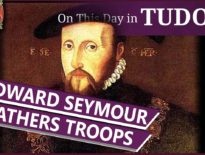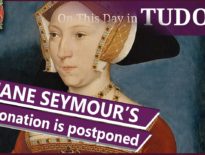On this day in Tudor history, 4th October 1507, Sir Francis Bigod, was born at Seaton, in Hinderwell, Yorkshire.
Bigod led an uprising in Yorkshire in January 1537, Bigod’s Rebellion, after the rebels of the Pilgrimage of Grace had been dispersed. But who was Bigod? Why would an evangelical reformer become involved with the Pilgrimage of Grace? What was his rebellion about and what happened to him?
Find out more about Sir Francis Bigod and Bigod's Rebellion in today's talk.
Also on this day in Tudor history, Wednesday 4th October 1536, trouble erupted in Horncastle, Lincolnshire. This was part of what we know as the Lincolnshire Rising which, in turn, was part of the famous Pilgrimage of Grace rebellion, which I have, of course, just mentioned. You can find out what happened in Horncastle, which included two murders, what the rebellion was all about, and how King Henry VIII responded to the rebel's grievances, in last year’s video:
Also on this day in history:
- 1531 – Baptism of Henry Stanley, 4th Earl of Derby, at Lathom House, Lancashire. He was the eldest son of Edward Stanley, 3rd Earl of Derby, and his wife, Dorothy (née Howard). Derby served Elizabeth I as an Ambassador, Privy Councillor and Lord High Steward at the trial of Philip Howard, Earl of Arundel and Surrey.
- 1539 – Signing of the marriage treaty between Henry VIII and Anne of Cleves.
- 1556 – John Cheke made a public recantation of his Protestant faith in front of Queen Mary I.
- 1581 – Death of Henry Wriothesley, 2nd Earl of Southampton, at Itchel in Hampshire. He was buried at Titchfield.
Transcript:
On this day in Tudor history, 4th October 1507, Sir Francis Bigod, was born at Seaton, Hinderwell, Yorkshire.
Bigod led an uprising in Beverley, Yorkshire, in January 1537, which became known as Bigod’s Rebellion, but who was Bigod, what was his rebellion about and what happened to him?
• Francis Bigod was the eldest son of Sir John Bigod and Joan Strangeways, and was descended from the Bigods who had been Earls of Norfolk up until the 14th century and the Lords Maulay of Mulgrave Castle in Yorkshire.
• His father died in 1513 or 1514 and his paternal grandfather died in 1515, leaving Francis as his heir. Francis, who was seven at the time, became a ward of Cardinal Thomas Wolsey and was educated at Oxford.
• At the age of 21, he married Katherine Conyers, daughter of William Conyers, 1st Baron Conyers, and the couple went on to have a son, Ralph, and a daughter, Dorothy. Bigod was knighted in late 1529.
• Bigod was a reformer. Churchman and historian John Bale described him as “a lover of evangelical truth”, and Bigod corresponded with reformers including Thomas Garrett, and even considered entering the church.
• He served as a Justice of the Peace from 1532 and as a member of Parliament in 1529 and 1536, and in 1535 he served Thomas Cromwell and King Henry VIII in the survey of church wealth known as the valor ecclesiasticus, which led to the dissolution of the monasteries. He was also involved in enforcing the royal supremacy and punishing those who didn’t respond favourably. Bigod, however, supported reform of the monasteries rather than their dissolution.
• Bigod, as a reformer, initially opposed the Catholic Pilgrimage of Grace Rebellion of autumn 1536 and fled from his home Mulgrave Castle by sea. When he landed at Hartlepool, he narrowly avoided being lynched by the rebels, but was captured when he returned to Mulgrave. It was sometime soon after, that he realised that he had grievances in common with the rebels, such as his opposition to the king’s intervention in religion. The Pilgrimage of Grace rebellion came to an end in late 1536 after the king made promises to the rebels. Bigod was sceptical and launched his own rebellion in January 1537 with the support of his tenant John Hallam.
Bigod sent out the rebels’ articles around the north and even spoke from a hilltop, trying to rally support from former rebels, but his plans to seize Scarborough and Hull failed. On 19th January, a dawn raid at Beverley in Yorkshire saw the capture of 62 of his men and on 10th February, Bigod, who’d escaped the raid, was captured in Cumberland and taken to Carlisle Castle, where he was imprisoned.
• Sir Francis Bigod was hanged at Tyburn on 2nd June 1537 and buried at London’s Greyfriars.
• Unfortunately, even though Bigod’s Rebellion had been condemned by former Pilgrimage of Grace rebels like Robert Aske, it led to their undoing. Aske, Lord Darcy, Lord Hussey, Sir Thomas Percy and Sir Robert Constable were all convicted of treason and executed, along with several others.



Leave a Reply